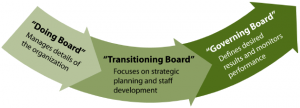
In this article, we’re going to highlight two important decisions that can throw a Board into turmoil – along with some tips on how to navigate them.
 The life of a non-profit Board typically follows a somewhat predictable rhythm where Board meetings consist of reports from committees and staff, along with discussions about fundraising goals, advocacy activities, and Board outreach efforts. These periods of normalcy can change, however, to periods of acute stress and anxiety when the Board is called on to make crucial decisions. (Download the PDF)
The life of a non-profit Board typically follows a somewhat predictable rhythm where Board meetings consist of reports from committees and staff, along with discussions about fundraising goals, advocacy activities, and Board outreach efforts. These periods of normalcy can change, however, to periods of acute stress and anxiety when the Board is called on to make crucial decisions. (Download the PDF)
Whether it’s an unexpected departure or the planned retirement of your chief executive, it will most likely expose one or more of the following issues that may not have surfaced previously:
In our experience, it’s best to define the decisions that will need to be made up front. You can build understanding and consensus around who will make each decision – and how much consultation with the Board is needed at each step. The clearer the expectations, the less likelihood for problems later in the process.
For example, many non-profit Boards are focused today on increasing diversity, equity, and inclusion. This is a good goal. But how quickly does the Board wants to transform itself? Is it willing to ask current members to leave to make room for new members? What’s the right mix of new vs. old members? Related discussions include:
Developing a shared vision for transforming the Board takes time and patience. An expert in facilitating change may be an important factor in success – and assuring the decision to transform doesn’t result in bitter feelings down the road.
Next Post: Tips for Non-Profits to Manage Complex, Multi-Funder Projects
This post was originally published at the Sacramento Business Journal.
Leading Resources, Inc. is a Sacramento Board Governance Consulting firm that develops leaders and leading organizations. Subscribe to our leadership development newsletter to download the PDF – “The 6 Trust-Building Habits of Leaders” to learn more about how to build trust with your team.